Art has long been heralded as a way to express, reflect, and understand emotions. While both men and women face the same complex emotional landscapes, societal pressures often discourage men from exploring their feelings openly. From an early age, boys are conditioned to be stoic, to keep their emotions in check, and to resolve problems with logic rather than introspection. In this context, activities such as painting and drawing can offer men an outlet for emotional expression that is both cathartic and insightful. Through these creative practices, men can process their emotions in a safe and constructive way, leading to improved mental health and overall well-being.
Breaking Down the Emotional Barriers
For many men, expressing emotions through words can be a daunting task. The fear of being judged, misunderstood, or seen as weak can inhibit their ability to process and communicate feelings. This is where painting and drawing can step in. These artistic outlets provide a non-verbal, visual language that allows men to bypass the limitations of speech. The very act of creating something with their hands can serve as a bridge between the internal world of thoughts and feelings and the external world of expression.
Art offers a form of introspection that encourages men to connect with their emotions without the pressure to articulate them. A person may not always be able to explain their sadness, anger, or joy in words, but by using a brush or pencil, they can express these feelings visually. Whether through the use of color, shape, or texture, the artwork becomes an extension of the creator's inner world. This non-verbal mode of expression helps to validate their emotions, offering a sense of release and relief from the internal turmoil that might otherwise remain unaddressed.
The Role of Art in Mental Health
Mental health is an essential aspect of well-being, and art can play a significant role in maintaining it. Many men experience mental health challenges, yet are less likely to seek therapy or counseling due to societal stigma surrounding vulnerability and emotional openness. In such cases, drawing and painting offer a powerful alternative form of therapy.
Studies have shown that engaging in creative practices like art can reduce stress, lower anxiety, and combat depression. This is particularly significant for men, as research suggests that they are more likely to internalize negative emotions or express them through anger or aggression rather than seeking help. When men turn to art as a means of processing their emotions, they engage in a healing activity that allows them to work through their thoughts in a less confrontational, more self-reflective manner.
One of the most significant advantages of art is its ability to provide a safe space for emotional exploration. Men may feel more comfortable expressing feelings that they otherwise struggle to verbalize. For example, creating an abstract painting might allow them to explore the feelings they associate with loss, frustration, or fear without having to directly confront these emotions. The process of making art becomes less about the final product and more about the experience of engagement, allowing for deeper emotional insight.
How Painting and Drawing Encourage Self-Reflection
The therapeutic power of painting and drawing lies not only in the act of creating but in the process of self-reflection it encourages. These activities promote mindfulness, which can help individuals gain a better understanding of their thoughts and feelings. As men work through a piece of art, they may find themselves asking questions like, "Why did I choose these colors?" or "What does this shape represent to me?" These questions encourage self-awareness and open the door to a deeper understanding of emotions.
In fact, art has long been used as a tool for self-discovery. The physical act of putting pen to paper or brush to canvas becomes an invitation for introspection. In this way, men can use their creations to explore their identity, life experiences, and the emotions tied to those experiences. Drawing or painting can serve as a mirror, reflecting their internal world and allowing them to see it in a new light. The results of this self-reflection can provide men with a sense of clarity, helping them process emotions and gain insight into their behavior and thought patterns.
Additionally, creating art encourages men to slow down and be present in the moment. In our fast-paced world, it’s easy to become distracted and disconnected from our emotions. Painting and drawing provide an opportunity to step back, focus, and reconnect with one's inner self. The act of creating something from scratch forces the individual to remain present, fostering mindfulness that can translate to other areas of life, such as relationships, work, and personal growth.
A Tool for Managing Stress and Anxiety
Stress and anxiety are two common emotions that men often struggle with in silence. The demands of work, family life, and societal expectations can create overwhelming pressure, and for many men, this leads to feelings of tension and unease. Rather than verbalizing their stress, men may turn to coping mechanisms that do not address the underlying emotional issues—such as substance use, anger, or withdrawal.
Art provides a healthy and productive way to manage stress and anxiety. When men engage in drawing or painting, they enter a form of "flow" state, where their focus is entirely absorbed in the creative process. This level of concentration can be incredibly soothing, allowing the individual to take a mental break from their daily worries and anxieties. The act of creating art can help to regulate emotions, reduce mental clutter, and create a sense of calm in the midst of chaos
Moreover, the repetitive motions involved in drawing or painting, such as the back-and-forth movement of a brush or pencil, have a calming effect on the nervous system. These rhythmic actions can help lower heart rates, reduce muscle tension, and promote relaxation, much like other mindfulness practices such as deep breathing or meditation.
Additionally, the act of completing a painting or drawing can provide a sense of accomplishment, which can boost self-esteem and provide a much-needed emotional lift. For men who may struggle with feelings of inadequacy or frustration, creating something tangible can serve as a reminder of their creativity, resilience, and ability to overcome challenges.
Building Emotional Resilience Through Art
Another benefit of painting and drawing is the way they help build emotional resilience. The process of creating art involves trial and error, mistakes, and the need to adapt and problem-solve. These challenges mirror the ups and downs of life itself, teaching men how to cope with setbacks and continue moving forward.
When faced with a difficult emotion, men can use art as a way to externalize their feelings and gain perspective. For example, drawing a representation of anger or frustration might allow them to view the emotion as something separate from themselves. This separation can help reduce the intensity of the feeling and create space for the individual to process it more effectively. The act of creating becomes an act of emotional regulation, teaching men how to navigate difficult emotions with greater ease.
Furthermore, completing an artwork gives men a sense of closure. Often, emotions can feel overwhelming because they lack resolution. Art allows men to create something that is final, providing a sense of accomplishment and closure. Whether the piece is perfect or not, the act of completing it is a form of emotional release, helping men process their feelings and move on from them.
Building Connections Through Shared Artistic Expression
Although painting and drawing can be deeply personal practices, they can also serve as a means of connecting with others. Many men find comfort in joining art communities, whether through formal classes, online groups, or informal gatherings. Sharing their work with others and receiving feedback can provide a sense of belonging and validation, helping to reduce feelings of isolation.
Moreover, art fosters empathy. When men share their work with others, they open up a space for mutual understanding and emotional exchange. This can be particularly important for men who may feel disconnected from their emotions or struggle to find others who understand their experiences. Art allows for shared vulnerability in a way that feels natural and unthreatening, offering a form of communication that transcends words.
Conclusion
Painting and drawing offer men a powerful tool for emotional expression, self-reflection, stress management, and mental health. These artistic outlets provide a means of processing complex feelings that might otherwise remain hidden or suppressed. By engaging in creative activities, men can develop a healthier relationship with their emotions, improve their mental well-being, and enhance their emotional resilience. Moreover, art encourages mindfulness, empathy, and connection, helping men build meaningful relationships with others and with themselves.
In a world where emotional expression is often undervalued or misunderstood, painting and drawing stand as essential practices for men seeking to navigate the complexities of their emotions. Through art, men can reclaim the power of self-expression and embark on a journey of healing, growth, and understanding.


